by Calculated Risk on 11/04/2016 03:31:00 PM
Friday, November 04, 2016
Public and Private Sector Payroll Jobs: Carter, Reagan, Bush, Clinton, Bush, Obama
By request, here is another update of an earlier post through the October 2016 employment report including all revisions.
NOTE: Several readers have asked if I could add a lag to these graphs (obviously a new President has zero impact on employment for the month they are elected). But that would open a debate on the proper length of the lag, so I'll just stick to the beginning of each term.
Note: We frequently use Presidential terms as time markers - we could use Speaker of the House, or any other marker.
Important: There are many differences between these periods. Overall employment was smaller in the '80s, however the participation rate was increasing in the '80s (younger population and women joining the labor force), and the participation rate is generally declining now. But these graphs give an overview of employment changes.
First, here is a table for private sector jobs. The top two private sector terms were both under President Clinton. Reagan's 2nd term saw about the same job growth as during Carter's term. Note: There was a severe recession at the beginning of Reagan's first term (when Volcker raised rates to slow inflation) and a recession near the end of Carter's term (gas prices increased sharply and there was an oil embargo).
| Term | Private Sector Jobs Added (000s) |
|---|---|
| Carter | 9,041 |
| Reagan 1 | 5,360 |
| Reagan 2 | 9,357 |
| GHW Bush | 1,510 |
| Clinton 1 | 10,884 |
| Clinton 2 | 10,082 |
| GW Bush 1 | -811 |
| GW Bush 2 | 415 |
| Obama 1 | 1,921 |
| Obama 2 | 9,3221 |
| 145 months into 2nd term: 9,943 pace. | |
The first graph shows the change in private sector payroll jobs from when each president took office until the end of their term(s). Presidents Carter and George H.W. Bush only served one term, and President Obama is in the final months of his second term.
Mr. G.W. Bush (red) took office following the bursting of the stock market bubble, and left during the bursting of the housing bubble. Mr. Obama (blue) took office during the financial crisis and great recession. There was also a significant recession in the early '80s right after Mr. Reagan (yellow) took office.
There was a recession towards the end of President G.H.W. Bush (purple) term, and Mr Clinton (light blue) served for eight years without a recession.
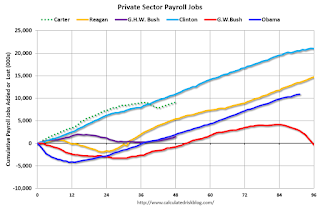 Click on graph for larger image.
Click on graph for larger image.The first graph is for private employment only.
The employment recovery during Mr. G.W. Bush's (red) first term was sluggish, and private employment was down 811,000 jobs at the end of his first term. At the end of Mr. Bush's second term, private employment was collapsing, and there were net 396,000 private sector jobs lost during Mr. Bush's two terms.
Private sector employment increased slightly under President G.H.W. Bush (purple), with 1,510,000 private sector jobs added.
Private sector employment increased by 20,966,000 under President Clinton (light blue), by 14,717,000 under President Reagan (yellow), and 9,041,000 under President Carter (dashed green).
There were only 1,921,000 more private sector jobs at the end of Mr. Obama's first term. Forty five months into Mr. Obama's second term, there are now 11,243,000 more private sector jobs than when he initially took office.
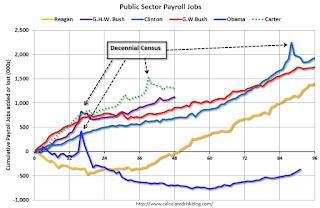 A big difference between the presidencies has been public sector employment. Note the bumps in public sector employment due to the decennial Census in 1980, 1990, 2000, and 2010.
A big difference between the presidencies has been public sector employment. Note the bumps in public sector employment due to the decennial Census in 1980, 1990, 2000, and 2010. The public sector grew during Mr. Carter's term (up 1,304,000), during Mr. Reagan's terms (up 1,414,000), during Mr. G.H.W. Bush's term (up 1,127,000), during Mr. Clinton's terms (up 1,934,000), and during Mr. G.W. Bush's terms (up 1,744,000 jobs).
However the public sector has declined significantly since Mr. Obama took office (down 344,000 jobs). This has been a significant drag on overall employment.
And a table for public sector jobs. Public sector jobs declined the most during Obama's first term, and increased the most during Reagan's 2nd term.
| Term | Public Sector Jobs Added (000s) |
|---|---|
| Carter | 1,304 |
| Reagan 1 | -24 |
| Reagan 2 | 1,438 |
| GHW Bush | 1,127 |
| Clinton 1 | 692 |
| Clinton 2 | 1,242 |
| GW Bush 1 | 900 |
| GW Bush 2 | 844 |
| Obama 1 | -708 |
| Obama 2 | 3641 |
| 145 months into 2nd term, 388 pace | |
Looking forward, I expect the economy to continue to expand through the remainder of Mr. Obama's presidency, so I don't expect a sharp decline in private employment as happened at the end of Mr. Bush's 2nd term (In 2005 and 2006 I was warning of a coming down turn due to the bursting of the housing bubble - and I predicted a recession in 2007).
For the public sector, the cutbacks are over. Right now I'm expecting some further increase in public employment during the last few months of Obama's 2nd term, but obviously nothing like what happened during Reagan's second term.
Below is a table of the top four presidential terms for private job creation (they also happen to be the four best terms for total non-farm job creation).
Clinton's two terms were the best for both private and total non-farm job creation, followed by Reagan's 2nd term.
Currently Obama's 2nd term is on pace to be the 3rd best ever for private job creation. However, with very few public sector jobs added, Obama's 2nd term is only on pace to be the fifth best for total job creation.
Note: Only 364 thousand public sector jobs have been added during the forty five months of Obama's 2nd term (following a record loss of 708 thousand public sector jobs during Obama's 1st term). This is about 25% of the public sector jobs added during Reagan's 2nd term!
| Top Employment Gains per Presidential Terms (000s) | ||||
|---|---|---|---|---|
| Rank | Term | Private | Public | Total Non-Farm |
| 1 | Clinton 1 | 10,884 | 692 | 11,576 |
| 2 | Clinton 2 | 10,082 | 1,242 | 11,312 |
| 3 | Reagan 2 | 9,357 | 1,438 | 10,795 |
| 4 | Carter | 9,041 | 1,304 | 10,345 |
| 5 | Obama 21 | 9,322 | 364 | 9,686 |
| Pace2 | 9,943 | 388 | 10,332 | |
| 145 Months into 2nd Term 2Current Pace for Obama's 2nd Term | ||||
The last table shows the jobs needed per month for Obama's 2nd term to be in the top four presidential terms. Right now it looks like Obama's 2nd term will be the 3rd best for private employment (behind Clinton's two terms, and ahead of Reagan) and probably 4th or 5th for total employment.
| Average Jobs needed per month (000s) for remainder of Obama's 2nd Term | ||||
|---|---|---|---|---|
| to Rank | Private | Total | ||
| #1 | 521 | 630 | ||
| #2 | 253 | 546 | ||
| #3 | 12 | 370 | ||
| #4 | -94 | 220 | ||
Trade Deficit at $36.4 Billion in September
by Calculated Risk on 11/04/2016 12:55:00 PM
Earlier from the Department of Commerce reported:
The U.S. Census Bureau and the U.S. Bureau of Economic Analysis, through the Department of Commerce, announced today that the goods and services deficit was $36.4 billion in September, down $4.0 billion from $40.5 billion in August, revised. September exports were $189.2 billion, $1.0 billion more than August exports. September imports were $225.6 billion, $3.0 billion less than August imports.The trade deficit was larger than the consensus forecast of $38.9 billion (expect a small upward revision to Q3 GDP).
The first graph shows the monthly U.S. exports and imports in dollars through September 2016.
 Click on graph for larger image.
Click on graph for larger image.Imports decreased and exports increased in September.
Exports are 14% above the pre-recession peak and up 1% compared to September 2015; imports are down 1% compared to September 2015.
It appears trade might be picking up a little.
The second graph shows the U.S. trade deficit, with and without petroleum.
 The blue line is the total deficit, and the black line is the petroleum deficit, and the red line is the trade deficit ex-petroleum products.
The blue line is the total deficit, and the black line is the petroleum deficit, and the red line is the trade deficit ex-petroleum products.Oil imports averaged $39.02 in September, down from $39.38 in August, and down from $42.72 in September 2015. The petroleum deficit has generally been declining and is the major reason the overall deficit has declined a little since early 2012.
The trade deficit with China decreased to $32.4 billion in September, from $36.3 billion in September 2015. The deficit with China is a substantial portion of the overall deficit, but the deficit with China has been declining.
Comments: Solid October Employment Report, Pickup in Wage Growth
by Calculated Risk on 11/04/2016 09:55:00 AM
The headline jobs number was decent. Job growth was somewhat below the consensus forecast (161,000 vs forecast of 170,000), however job growth for August and September were revised up - and the unemployment rate ticked down to 4.9%.
Earlier: October Employment Report: 161,000 Jobs, 4.9% Unemployment Rate
Job growth has averaged 181,000 per month this year.
In October, the year-over-year change was 2.36 million jobs - a solid gain.
Average Hourly Earnings

This graph is based on “Average Hourly Earnings” from the Current Employment Statistics (CES) (aka "Establishment") monthly employment report. Note: There are also two quarterly sources for earnings data: 1) “Hourly Compensation,” from the BLS’s Productivity and Costs; and 2) the Employment Cost Index which includes wage/salary and benefit compensation.
The graph shows the nominal year-over-year change in "Average Hourly Earnings" for all private employees. Nominal wage growth was at 2.8% YoY in October. This series is noisy, however overall wage growth is trending up - especially over the last year and a half.
Note: CPI has been running around 2%, so there has been real wage growth.
Seasonal Retail Hiring
According to the BLS employment report, retailers hired seasonal workers in October at a lower pace than the last two years.
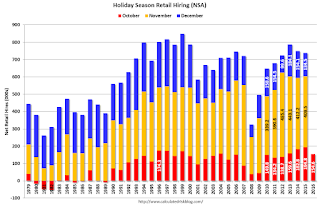
This graph really shows the collapse in retail hiring in 2008. Since then seasonal hiring has increased back close to more normal levels. Note: I expect the long term trend will be down with more and more internet holiday shopping.
Retailers hired 155 thousand workers (NSA) net in October. Note: this is NSA (Not Seasonally Adjusted).
This suggests retailers are a little cautious about the holiday season. Note: There is a decent correlation between October seasonal retail hiring and holiday retail sales.
Employment-Population Ratio, 25 to 54 years old

In the earlier period the participation rate for this group was trending up as women joined the labor force. Since the early '90s, the participation rate moved more sideways, with a downward drift starting around '00 - and with ups and downs related to the business cycle.
The 25 to 54 participation rate increased in October to 81.6%, and the 25 to 54 employment population ratio increased to 78.2%.
The participation rate has been trending down for this group since the late '90s, however, with more younger workers (and fewer older workers), the participation rate might move up some more.
Part Time for Economic Reasons

The number of persons employed part time for economic reasons (also referred to as involuntary part-time workers) was unchanged in October at 5.9 million. These individuals, who would have preferred full-time employment, were working part time because their hours had been cut back or because they were unable to find a full-time job.The number of persons working part time for economic reasons was essentially unchanged in October. This level suggests slack still in the labor market.
These workers are included in the alternate measure of labor underutilization (U-6) that declined to 9.5% in October. This is the lowest level for U-6 since May 2008.
Unemployed over 26 Weeks
 This graph shows the number of workers unemployed for 27 weeks or more.
This graph shows the number of workers unemployed for 27 weeks or more. According to the BLS, there are 1.979 million workers who have been unemployed for more than 26 weeks and still want a job. This was up slightly from 1.974 million in September.
This is generally trending down, but is still high.
There are still signs of slack (as example, elevated level of part time workers for economic reasons and U-6), but there also signs the labor market is tightening.
Overall this was another solid report.
October Employment Report: 161,000 Jobs, 4.9% Unemployment Rate
by Calculated Risk on 11/04/2016 08:42:00 AM
From the BLS:
Total nonfarm payroll employment rose by 161,000 in October, and the unemployment rate was little changed at 4.9 percent, the U.S. Bureau of Labor Statistics reported today. Employment continued to trend up in health care, professional and business services, and financial activities.
...
The change in total nonfarm payroll employment for August was revised up from +167,000 to +176,000, and the change for September was revised up from +156,000 to +191,000. With these revisions, employment gains in August and September combined were 44,000 more than previously reported.
...
In October, average hourly earnings for all employees on private nonfarm payrolls rose by 10 cents to $25.92, following an 8-cent increase in September. Over the year, average hourly earnings have risen by 2.8 percent.
emphasis added
 Click on graph for larger image.
Click on graph for larger image.The first graph shows the monthly change in payroll jobs, ex-Census (meaning the impact of the decennial Census temporary hires and layoffs is removed - mostly in 2010 - to show the underlying payroll changes).
Total payrolls increased by 161 thousand in October (private payrolls increased 142 thousand).
Payrolls for August and September were revised up by a combined 44 thousand.
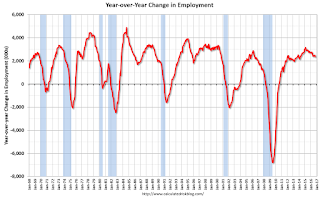 This graph shows the year-over-year change in total non-farm employment since 1968.
This graph shows the year-over-year change in total non-farm employment since 1968.In October, the year-over-year change was 2.36 million jobs. A solid gain.
The third graph shows the employment population ratio and the participation rate.
 The Labor Force Participation Rate decreased in September to 62.8%. This is the percentage of the working age population in the labor force. A large portion of the recent decline in the participation rate is due to demographics.
The Labor Force Participation Rate decreased in September to 62.8%. This is the percentage of the working age population in the labor force. A large portion of the recent decline in the participation rate is due to demographics. The Employment-Population ratio decreased to 59.7% (black line).
I'll post the 25 to 54 age group employment-population ratio graph later.
 The fourth graph shows the unemployment rate.
The fourth graph shows the unemployment rate. The unemployment rate decreased in October to 4.9%.
This was slightly below expectations of 170,000 jobs, however job growth for August and September were revised up - and there was solid wage growth. A solid report.
I'll have much more later ...
Thursday, November 03, 2016
Friday: Employment Report, Trade Deficit
by Calculated Risk on 11/03/2016 08:08:00 PM
From Matthew Graham at Mortgage News Daily: Mortgage Rates Drift Higher Ahead of Jobs Report
Mortgage Rates were slightly higher today, keeping them in line with the weakest levels in just over 5 months. "Weakness" is relative, however. Apart from the past 5 months, and a few months in 2012, today's rates would rank among all-time lows. Day-to-day movement hasn't been extreme for the past few days, with most lenders continuing to quote 3.625% on top tier conventional 30yr fixed scenarios, and merely making small adjustments to the upfront costs depending on market movement.Friday:
emphasis added
• At 8:30 AM ET, Employment Report for October. The consensus is for an increase of 178,000 non-farm payroll jobs added in October, up from the 156,000 non-farm payroll jobs added in September. The consensus is for the unemployment rate to decline to 4.9%.
• Also at 8:30 AM, Trade Balance report for September from the Census Bureau. The consensus is for the U.S. trade deficit to be at $38.9 billion in September from $40.7 billion in August.
October Employment Preview
by Calculated Risk on 11/03/2016 03:53:00 PM
On Friday at 8:30 AM ET, the BLS will release the employment report for October. The consensus, according to Bloomberg, is for an increase of 178,000 non-farm payroll jobs in October (with a range of estimates between 155,000 to 200,000), and for the unemployment rate to decrease to 4.9%.
The BLS reported 156,000 jobs added in September.
Here are a few excerpts from Goldman Sachs' October Payroll Preview by economists Elad Pashtan and Zach Pandl:
We forecast an increase of 185k in nonfarm payroll employment for October, slightly above consensus expectations. An expected rebound in employment growth for state and local governments, as well as education- and health care-related industries, is a key reason for the acceleration from a 156k gain in payrolls in September.Here is a summary of recent data:
We look for a decline in the unemployment rate to 4.9%, which is now unusually high compared with continuing jobless claims. Favorable calendar effects as well as strengthening underlying wage tends likely boosted average hourly earnings by 0.3% month-over-month.
emphasis added
• The ADP employment report showed an increase of 147,000 private sector payroll jobs in October. This was below expectations of 170,000 private sector payroll jobs added. The ADP report hasn't been very useful in predicting the BLS report for any one month, but in general, this suggests employment growth somewhat below expectations.
• The ISM manufacturing employment index increased in October to 52.9%. A historical correlation between the ISM manufacturing employment index and the BLS employment report for manufacturing, suggests that private sector BLS manufacturing payroll decreased slightly in October. The ADP report indicated 1,000 manufacturing jobs lost in October.
The ISM non-manufacturing employment index decreased in October to 53.1%. A historical correlation between the ISM non-manufacturing employment index and the BLS employment report for non-manufacturing, suggests that private sector BLS non-manufacturing payroll jobs increased about 156,000 in October.
Combined, the ISM indexes suggests employment gains of about 155,000. This suggests employment growth somewhat below expectations.
• Initial weekly unemployment claims averaged 258,000 in October, up from 256,000 in September. For the BLS reference week (includes the 12th of the month), initial claims were at 252,000, up from 251,000 during the reference week in August.
The slight increase during the reference suggests about the same level of labor stress in October as in September. This suggests another positive employment report.
• The final October University of Michigan consumer sentiment index decreased to 87.2 from the September reading of 91.2. Sentiment is frequently coincident with changes in the labor market, but there are other factors too like gasoline prices and possibly politics.
• Conclusion: Unfortunately none of the indicators alone is very good at predicting the initial BLS employment report. The ADP and the ISM reports suggest weaker job growth. And it is possible Hurricane Matthew negatively impacted employment in a few states.
My guess is the October report will be below the consensus forecast.
Fannie and Freddie: REO inventory declined in Q3, Down 31% Year-over-year
by Calculated Risk on 11/03/2016 12:43:00 PM
Fannie and Freddie reported results this week. Here is some information on Real Estate Owned (REOs).
Freddie Mac reported the number of REO declined to 12,185 at the end of Q3 2106 compared to 17,780 at the end of Q3 2015.
For Freddie, this is down 84% from the 74,897 peak number of REOs in Q3 2010. For Freddie, this is the lowest since at least 2007.
Fannie Mae reported the number of REO declined to 41,973 at the end of Q3 2016 compared to 60,958 at the end of Q3 2015.
For Fannie, this is down 75% from the 166,787 peak number of REOs in Q3 2010. For Fannie, this is the lowest since Q4 2007.

Here is a graph of Fannie and Freddie Real Estate Owned (REO).
REO inventory decreased in Q3 for both Fannie and Freddie, and combined inventory is down 31% year-over-year.
Delinquencies are falling, but there are still a number of properties in the foreclosure process with long time lines in judicial foreclosure states - but this is getting close to normal levels of REOs.
ISM Non-Manufacturing Index declined to 54.8% in October
by Calculated Risk on 11/03/2016 10:04:00 AM
The September ISM Non-manufacturing index was at 54.8%, down from 57.1% in September. The employment index decreased in October to 53.1%, from 57.2%. Note: Above 50 indicates expansion, below 50 contraction.
From the Institute for Supply Management:October 2016 Non-Manufacturing ISM Report On Business®
Economic activity in the non-manufacturing sector grew in October for the 81st consecutive month, say the nation's purchasing and supply executives in the latest Non-Manufacturing ISM® Report On Business®.
The report was issued today by Anthony Nieves, CPSM, C.P.M., CFPM, chair of the Institute for Supply Management® (ISM®) Non-Manufacturing Business Survey Committee. "The NMI® registered 54.8 percent in October, 2.3 percentage points lower than the September reading of 57.1 percent. This represents continued growth in the non-manufacturing sector at a slower rate. The Non-Manufacturing Business Activity Index decreased to 57.7 percent, 2.6 percentage points lower than the September reading of 60.3 percent, reflecting growth for the 87th consecutive month, at a slower rate in October. The New Orders Index registered 57.7 percent, 2.3 percentage points lower than the reading of 60 percent in September. The Employment Index decreased 4.1 percentage points in October to 53.1 percent from the September reading of 57.2 percent. The Prices Index increased 2.6 percentage points from the September reading of 54 percent to 56.6 percent, indicating prices increased in October for the seventh consecutive month. According to the NMI®, 13 non-manufacturing industries reported growth in October. There has been a slight cooling-off in the non-manufacturing sector month-over-month, indicating that last month’s increases weren’t sustainable. Respondent’s comments remain mostly positive about business conditions and the overall economy. Several comments were made about the uncertainty on the impact of the upcoming U.S. presidential election."
emphasis added
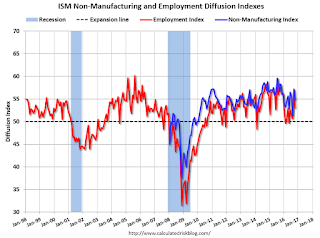 Click on graph for larger image.
Click on graph for larger image.This graph shows the ISM non-manufacturing index (started in January 2008) and the ISM non-manufacturing employment diffusion index.
This was below the consensus forecast of 56.1, and suggests slower expansion in October than in September.
Weekly Initial Unemployment Claims increase to 265,000
by Calculated Risk on 11/03/2016 08:34:00 AM
The DOL reported:
In the week ending October 29, the advance figure for seasonally adjusted initial claims was 265,000, an increase of 7,000 from the previous week's unrevised level of 258,000. The 4-week moving average was 257,750, an increase of 4,750 from the previous week's unrevised average of 253,000.The previous week was unrevised.
There were no special factors impacting this week's initial claims. This marks 87 consecutive weeks of initial claims below 300,000, the longest streak since 1970.
The following graph shows the 4-week moving average of weekly claims since 1971.
 Click on graph for larger image.
Click on graph for larger image.The dashed line on the graph is the current 4-week average. The four-week average of weekly unemployment claims increased to 257,750.
This was above the consensus forecast. The low level of claims suggests relatively few layoffs.
Wednesday, November 02, 2016
Thursday: Unemployment Claims, ISM non-Mfg Index
by Calculated Risk on 11/02/2016 07:16:00 PM
From Tim Duy at Fed Watch: Fed Remains On The Sidelines, Excerpt:
As expected, the Federal Reserve left policy unchanged this month. The statement itself was largely unchanged as well. .... Thursday:
We get two employment reports before the December meeting; for the Fed to stay on the sidelines yet again, we probably need to see both reports come in weak. The first one - for October - comes Friday morning. ADP estimates that private payrolls will be up 147k - not surging, but still easily sufficient for the Fed to justify a rate hike. If this comes to pass, we would probably need a deluge of soft numbers to keep the Fed on hold again.
Bottom Line: Fed is looking past the election to the December meeting for its second move in this rate hike cycle. Probably need some unlikely softer numbers to hold them back again
• At 8:30 AM ET, The initial weekly unemployment claims report will be released. The consensus is for 255 thousand initial claims, down from 258 thousand the previous week.
• At 10:00 AM, Manufacturers' Shipments, Inventories and Orders (Factory Orders) for September. The consensus is a 0.2% increase in orders.
• Also at 10:00 AM, the ISM non-Manufacturing Index for October. The consensus is for index to decrease to 56.1 from 57.1 in August.


